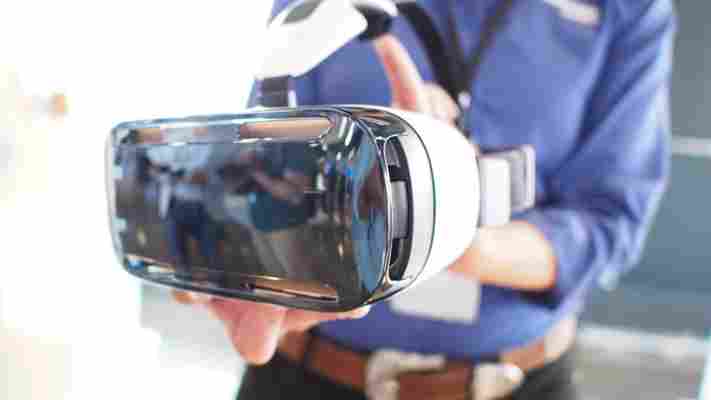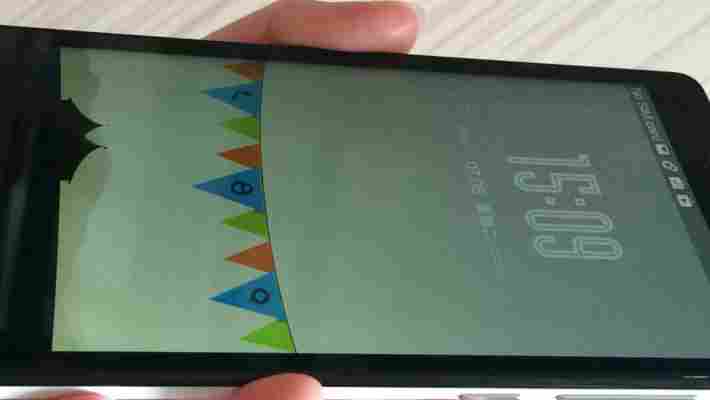We had months in advance to prep for the launch of Samsung’s latest Note device , but when the Gear VR headset popped up on the radar last month , it actually did something we hadn’t felt about Samsung in a while. It got us curious, excited and even more intrigued by the partnership with Oculus.

The Samsung Gear VR is a stripped down version of the Oculus Rift, relying on the Galaxy Note 4 as the screen to power your virtual realm. All you have to do is insert the phone into the dedicated slot up front, strap the headset on and select whether to play the sound off its speakers or via headphones. Behind the front pocket are two lenses that converts the Note’s screen into a 3D display.
The right side of the Gear VR is where all the controls take place. A square, touch-sensitive pad lets you tap to confirm action, while a return button right above it lets you cancel commands or move back to the main screen. To navigate, you just move your head around to explore the screen, which feels as awkward as it sounds.
In the demo we got to play with today, we were immersed into an Avengers game that puts us in Tony Stark’s control room. Although the Gear VR comes with a separate hand controller, the demo only allowed us to look around and check out Iron Man’s gadgets (which includes a bunch of Samsung devices, naturally).
The headset lets us turn 360 degree to explore the 3D environment, which moved quite smoothly. You can also use a dial located between your eyes to focus the graphics. Admittedly, I have a hard time imagining how a person who wears glasses can do this comfortably.
Unfortunately, the game did not allow us to interact with any of the objects in the room, but the graphics did look bright and crisp. The weight of the headset is also not bothersome, but I wouldn’t recommend wearing the device for longer than an hour unless you’re craving a headache from the combination of the Gear VR’s weight, the strap around your head and 3D effects.
With the original Oculus Rift development kit already starting at $350, it’s hard to say how Samsung will price the Gear VR. Our best bet is that it will offer a bundle with the Note 4 or Note Edge, with the gaming controller as an extra cost.
The idea is definitely still novelty, but it’s cool to know that all it takes to power virtual reality is a strange headset and a giant smartphone. Whether or not the Gear VR will take off with the general market will depend on the pricing, though it is certainly more accessible now that it’s associated with a popular gadget brand.
Check out our hands-on of the other devices Samsung announced today:
Samsung Galaxy Note 4 hands-on: More of the same, but that might not be a bad thing
Samsung Galaxy Note Edge hands-on: Curved OLED never looked so cool
15 stylish and creative gift ideas
One thing about TNW readers is that as well as being obsessed with technology, many of you are creative and have a great sense of style, too.

In this guide, we’ve collected 15 ideas like speakers, sunglasses, a wearable camera… even a neat way to tidy up your cables. In fact, let’s start right there…
“ The Cord Taco 5-Pack will help you clean up all of those wires in your bag, pocket, car or wherever they are.”
$23.75
Click the image for more information.
This useful accessory is the perfect home for your phone, wallet, keys and more. You can even feed a charging cable in, to keep your phone juiced up.
$133
Click the image for more information.
“A thick 10mm leather bracelet that is uniquely weaved producing a luxurious look.”
$60
Click the image for more information.
$50
“For the bold and the beautiful, thick and shiny mustache cufflinks .”
Click the image for more information.
“ The SlateGo is chiseled from a sheet of pure, premium bamboo. It’s ultra lightweight, super strong, and it will absorb the heat from your laptop.”
$72
Click the image for more information.
“ The Porter utilizes a combination of luxurious materials to make a bold yet refined statement.”
$160
Click the image for more information.
“ Coffin shaped ring with an engraved cross . Casted stainless in silver or with 18k gold plating (gold, rose gold).”
$34.20
Click the image for more information.
“Meet the new Generation 2 AeroFLY 2.0 A modern fashion design with sustainable materials in mind. ”
$54.15
Click the image for more information.
“ The 11+ Sound1 Speaker pairs with Bluetooth enabled portable devices and computers to provide beautifully clear and crisp stereo sound.(2X3W).”
$85
Click the image for more information.
“A gorgeously simple way to wrap your USB cords, earbuds, plugs, this Cordito (cord wrap) holds 3 cables & 2 plugs.”
$45
Click the image for more information.
“You’ll think you’re holding a magic wand with the 3Doodler 3D Printing Free Hand Pen . It lets you sculpt objects and sculptures in 3D!”
$100
Click the image for more information.
“ This Batman decal is perfect for all fans of the Gotham City hero. Available for iPhone 5s, 5c, 6, and 6 Plus.”
$4.75
Click the image for more information.
“ The Stampler looks and works like anormal stapler but has an added attachment that prints a smiling face design at the same time.”
$12
Click the image for more information.
“ The Chikuno Cube is an air purifier that works naturally, transforming your living spaces in an eco-friendly way.”
$64.60
Click the image for more information.
“ The Narrative Clip gives you a photographic memory for the moments that matter. It’s a tiny camera that you wear on your clothes, and automatically takes two photos per minute.
$217.55
Click the image for more information.
Disclosure: This article contains an affiliate link. While we only ever write about products we think deserve to be on the pages of our site, The Next Web may earn a small commission if you click through and buy the product in question.
Redmi Note review: A budget phablet that’s too clunky as a smartphone, but could replace a tablet
I’ve never understood the appeal of a phablet — what’s commonly known as a smartphone-tablet hybrid, or just a giant smartphone — as it seems to have an identity crisis.

Popular Chinese smartphone manufacturer Xiaomi took the wraps off its first phablet in March this year, the Redmi Note, a 5.5-inch version of its budget smartphone Redmi. The device made its way outside of greater China today with a launch in Singapore at a pricing of S$199 (US$159) and amazingly sold out in just 42 seconds .
The Redmi was warmly welcomed not only in China, but overseas markets — in Singapore, for example, the budget phone regularly sold out in minutes when sold in batches. It is little wonder that Xiaomi hopes to replicate the success with a larger version of the Redmi.
When I first held the Redmi Note, it almost fell out of my hands. The device is a tad heavy, weighing in at 199 grams. For comparison’s sake, the Sony Xperia C3, which was just launched today , is also a 5.5-inch device but weighs a mere 150g. Though the weight of the Redmi Note gives it a solid feel, it sure is clunky. Moreover, the glossy plastic backing becomes slippery and oily especially after a period of extended use, adding on to my overall problems with having a good grip on the device.
As for the screen, the 1280 x 720p IPS display delivers a more than decent visual experience, with vibrant colors and sharp images. However, as I used it to watch plenty of videos, I realized that the blacks on the screen tend to be too dark, and the shadows too harsh. Night scenes with low lighting within videos were also particularly grainy.
In terms of software, the Redmi Note runs Android 4.2.2 Jelly Bean customized with its own MIUI firmware. Xiaomi launched MIUI officially in English only earlier this year, but its system is a joy to use primarily because it’s easy to navigate. What I like most about Xiaomi’s software are its themes, which are basically different outfits for your phone — so you can change the entire look and feel of your phone easily by customizing the look of your phone via downloaded themes in the Mi Store and applying changes with a tap on the screen.
The Redmi Note is powered by an 8-core MTK 6592 1.7GHz processor and a 3,100 mAh battery that gives it plenty of juice. When Xiaomi CEO Lei Jun announced the device, he touted its stellar performance and power-saving capabilities.
Indeed, despite a large screen that typically saps a smartphone’s juice rapidly, the Redmi Note manages to chalk up a reasonable battery life span.
After charging it to full, the battery lasted about three days of light usage, in which I watched an hour or two of YouTube videos per day, sent a couple of emails, and took a few photos. Using it extremely intensively for an hour — in which I downloaded and played three resource-intensive games: Badland, GT Racing 2 and Angry Birds Go!, watched a YouTube video and browsed the web — saw the battery life deplete about 24 percent.
An octa-core processor powering the Redmi Note means that it operates on eight simultaneous cores, which is supposed to lead to more superior performance compared to just four cores — as the processor can allocate resources to different apps at the same time. For a budget device, the Redmi Note responds speedily when playing games.
However, it is for sure some way off from the Mi 3, which runs on a more powerful 2.3GHz quad-core Qualcomm Snapdragon 800 processor. In particular, playing games in which you need to tilt your phone gets a tad frustrating because there is just a very slight lag.
To play games and watch videos, sound is obviously a key factor — but this is where I find the Redmi Note lacking. The main problem I have is that the speakers are located in the bottom-right corner the back. This means that if I don’t plug in my earphones when watching a video or listening to music, the sound gets cast away from my direction. Most annoyingly, I can’t place the phone flat on a desk as it literally becomes muted.
For its price point, the Redmi Note actually comes equipped with more-than-decent camera specs — a 13-megapixel rear camera and a 5-megapixel front-facing one.
The rear-facing camera produces images that are generally crisp, detailed and sharp, but it disappoints in terms of colors under certain situations. The blacks tend to be a tad too harsh, while the general colors are flat when photos are taken outdoors with a lack of strong sunlight. Pictures also get very noisy in low-light situations and look washed out with a loss of detail. It seems like in general, Xiaomi’s smartphone cameras manage to come up with high-quality photos only under optimal lighting conditions.
However, keeping in mind that the Redmi Note is actually a budget device, the camera more than lives up to expectations — in fact I would think it’s on par with the Mi 3.
The Redmi Note still doesn’t convince me to change my mind about phablets, primarily because it occupies such an awkward position between a smartphone and a tablet — and it’s just too clunky for me to tote around making calls and texting on the go, especially with such slippery plastic backing. It just keeps falling out of my hands.
I could, however, envision myself giving up a tablet entirely and living with a comparatively more portable Redmi Note. After all, the Redmi Note is ideal for watching videos and playing games, which is what a tablet is primarily for.
Yet, as consumers are increasingly trending towards larger smartphones so they don’t have to carry around both a phone and a tablet, the Redmi Note would likely appeal to many who prefer a larger screen for their entertainment needs — and indeed, it acts as a perfect companion on long commutes.
